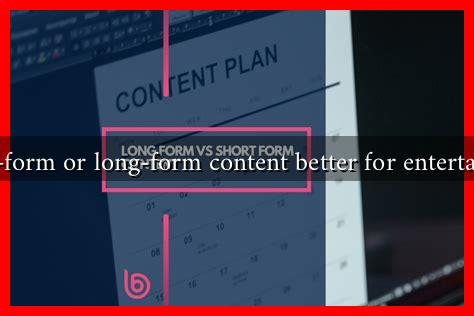-
Table of Contents
Is Short-Form or Long-Form Content Better for Entertainment?
In the digital age, content consumption has evolved dramatically, leading to a debate over the effectiveness of short-form versus long-form content in the realm of entertainment. With platforms like TikTok and Instagram promoting bite-sized videos, and streaming services like Netflix investing in lengthy series and films, understanding the nuances of these content types is essential for creators and consumers alike. This article explores the merits and drawbacks of both short-form and long-form content, providing insights into which format may be better suited for entertainment.
The Rise of Short-Form Content
Short-form content, typically defined as media that lasts less than 10 minutes, has surged in popularity due to its accessibility and convenience. Here are some key factors contributing to its rise:
- Attention Span: Studies suggest that the average human attention span has decreased, with many people preferring quick, digestible content. A report from Microsoft indicated that attention spans have dropped to around 8 seconds.
- Social Media Influence: Platforms like TikTok, Instagram Reels, and YouTube Shorts have made short-form content a staple of online entertainment, allowing users to consume multiple pieces of content in a short time.
- Shareability: Short videos and posts are easily shareable, making them more likely to go viral and reach a broader audience.
For example, TikTok has become a cultural phenomenon, with users creating and sharing 15 to 60-second videos that often include humor, dance, or challenges. The platform’s algorithm promotes content based on user engagement, making it easier for creators to gain visibility.
The Allure of Long-Form Content
On the other hand, long-form content, which typically exceeds 10 minutes, offers depth and detail that short-form content often lacks. Here are some advantages of long-form content:
- In-Depth Exploration: Long-form content allows for comprehensive storytelling, character development, and thematic exploration, making it ideal for genres like drama and documentary.
- Engagement: While it may require a greater time investment, long-form content can lead to deeper emotional connections with the audience. Viewers often become more invested in the characters and narratives.
- Quality Over Quantity: Long-form content often prioritizes quality, with creators spending more time on production, writing, and editing, resulting in a polished final product.
For instance, Netflix’s original series like “Stranger Things” and “The Crown” have captivated audiences with their intricate plots and character arcs, demonstrating the power of long-form storytelling in the entertainment industry.
Comparative Analysis: Short-Form vs. Long-Form
When comparing short-form and long-form content, several factors come into play:
- Audience Preferences: Younger audiences tend to favor short-form content due to its quick consumption, while older demographics may appreciate the depth of long-form narratives.
- Content Type: Certain genres, such as comedy and news, may thrive in short-form formats, while drama, documentaries, and in-depth analyses benefit from longer formats.
- Platform Suitability: The platform often dictates the content type. For example, YouTube is known for both short and long videos, while TikTok is predominantly short-form.
Case Studies and Statistics
Several studies and case analyses highlight the effectiveness of both content types:
- A study by HubSpot found that long-form blog posts (over 2,000 words) receive 77% more backlinks than shorter posts, indicating a preference for in-depth content in written formats.
- According to a report by Wistia, videos that are 2 minutes long receive the most engagement, while videos longer than 20 minutes see a significant drop in viewer retention.
These statistics suggest that while long-form content can be beneficial for certain platforms and audiences, short-form content remains highly effective for engagement and shareability.
Conclusion
In the debate between short-form and long-form content for entertainment, there is no definitive answer. Each format has its unique strengths and appeals to different audience preferences. Short-form content excels in accessibility and quick engagement, making it ideal for social media platforms. In contrast, long-form content offers depth and emotional connection, making it suitable for storytelling in films and series.
Ultimately, the choice between short-form and long-form content depends on the creator’s goals and the audience’s preferences. As the digital landscape continues to evolve, both formats will coexist, catering to diverse entertainment needs. For more insights on content strategies, you can explore resources from HubSpot and Wistia.


